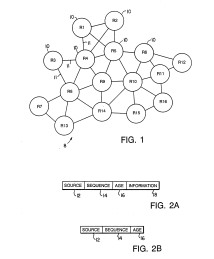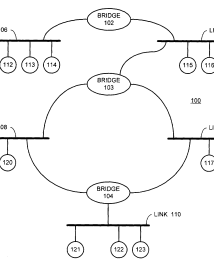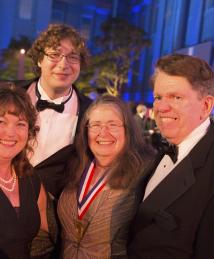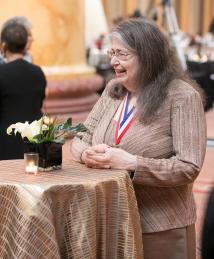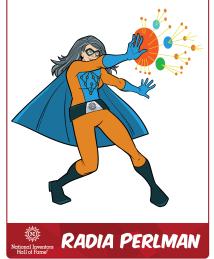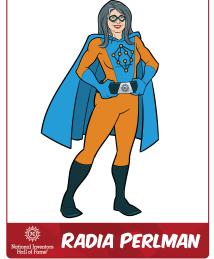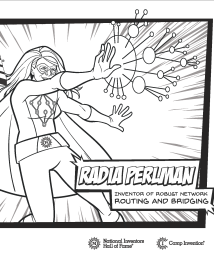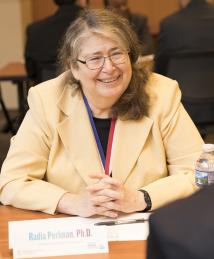Radia Perlman
"Music is very similar to a network in that there are all these different instruments playing their own parts, and somehow it fits together wonderfully."
Radia Perlman has played a major role in driving the growth and development of the internet. Her best-known contribution is the Spanning Tree Protocol (STP), which transformed Ethernet from a technology limited to a few hundred nodes confined within a single building into a technology that can create large networks with hundreds of thousands of computers. She also made fundamental contributions to internet routing, making routing more resilient, scalable and easy to manage. The protocols she designed in the 1980s remain widely deployed today.
Perlman was born in 1951 and grew up in New Jersey. Her parents were both engineers — her father worked on radar while her mother was a computer programmer. Perlman was introduced to computer programming when one of her high school teachers brought her to a class at the Stevens Institute of Technology. She said that she “loved and excelled at all academic classes in high school (though gym class was another story),” but in this class, she was “intimidated by other students bragging about how young they were when they built their first ham radio and asking questions with fancy words like ‘input.’” Having no idea what a ham radio was, she convinced herself she didn’t have the background for the class. However, when she was a sophomore at the Massachusetts Institute of Technology (MIT) in the 1970s, a teaching assistant in a physics class asked her if she’d like to be the programmer for his project and she agreed because she knew she had friends that could help her if necessary. She realized programming was actually easy and fun. Perlman says this early experience made her passionate about teaching. It taught her how important it is to not only present material clearly and with enthusiasm, but also ensure that students feel they can learn.
While an undergraduate, Perlman worked as a programmer in the Logo Lab at MIT. Logo is a language for teaching children around middle-school age to program. This inspired her to create TORTIS (Toddlers Own Recursive Turtle Interpreter System), hardware and software designed to teach programming concepts to children as young as 3. This work created the field of “tangible computing,” where computer instructions are physical objects that can be joined together to create programs.
After earning her bachelor’s and master’s degrees in mathematics from MIT in 1973 and 1976, respectively, Perlman joined BBN Technologies and began designing network protocols.
In 1980, she joined Digital Equipment Corp. (DEC) to design the routing algorithm for DEC’s network DECnet. Her design, which was adopted as the International Standard IS-IS (for Intermediate System to Intermediate System) protocol, is still used in much of the internet backbone.
A previous routing protocol, which worked for the size of the ARPANET (several hundred routers), would not work for larger networks. It also required experts to actively manage the network. As Perlman noted in one of her first published papers, the network could crash if a few bad messages were injected into it. (This actually occurred in the ARPANET, as Perlman predicted.) The way people diagnose and fix computer networks is to send messages across the network, but if the network is broken, this will not work. Perlman’s paper explained why computer networks must be self-stabilizing, meaning that once misbehaving nodes are disconnected from the network, the network should recover by itself. She explained the flaw in the ARPANET design and showed how to design a routing protocol that would be self-stabilizing. Additionally, her other innovations, which supported much larger networks and made networks much easier to manage, allowed large commercial networks to be deployed.
In the early 1980s, Ethernet links became commercially available. This was a new type of link (previous links were point-to-point, meaning there were only two computers on each link), and Perlman had to modify her routing protocol to work efficiently with some links shared by hundreds of nodes. Unfortunately, some people started deploying computers with the assumption that the entire network consisted of a single Ethernet link. Perlman stated, “I wish Ethernet had been called Etherlink. Ethernet is not an entire network. It is a link in a network.”
Although a real routing protocol, such as what Perlman had already designed, would be better than STP as a solution for moving data in a multilink network, a real routing protocol requires computers to cooperate with the routers by putting data in an envelope the routers understand. When Perlman originally invented STP, the challenge was to enable multilink networks with the already-deployed computers. Perlman said, “I assumed STP was a short-term fix that would last a few months until the deployed nodes could be upgraded to work with existing routers.” However, STP was so simple and easy to manage that it remains widely deployed today.
Returning to MIT, Perlman earned her doctorate in computer science in 1988. Her thesis expanded network resilience by having networks function despite misbehaving nodes participating in the network.
Perlman continues to make contributions to the industry in the areas of network protocols and network security, and she continues her passion for teaching. She is the author of “Interconnections,” a widely read text on network routing and bridging, and co-author of “Network Security,” a text on cryptography and how it is used in networks. She is currently co-teaching a class based on “Network Security” at Texas A&M University.
Perlman holds more than 200 U.S. patents. Her many honors include induction into the National Academy of Engineering and the Internet Hall of Fame, and lifetime achievement awards from ACM's SIGCOMM and USENIX. She is currently a Dell Technologies fellow, as well as a fellow of ACM and IEEE.
To encourage the next generation of creators and innovators, Perlman has served as a Judge for the Collegiate Inventors Competition® and visited Camp Invention® program sites, where children engage in hands-on invention. "The Camp Invention experience is that invention is for everyone,” said Perlman. “It is pure joy, collaboration and excitement.”
